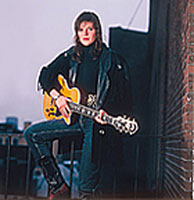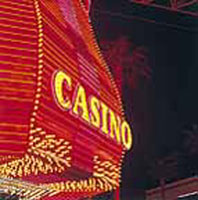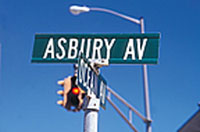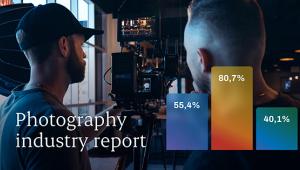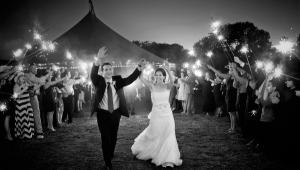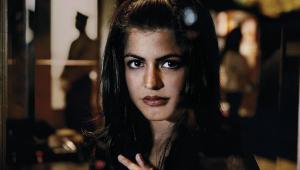The Long View
Taking Telephoto Lenses To The Extreme
I've always wanted really exotic lenses: super wide fisheyes, perspective control tilt and shift lenses, super fast rare earth element thoroughbreds, and super long telephotos. I've managed to buy, rent, or borrow just about everything out there in Canon EOS and Nikon AF mounts, but frankly the glass that I own is awfully pedestrian. Recently I switched my 35mm gear back to Nikon. While I personally prefer the EOS cameras to practically any other camera out there, I have two studio digital cameras that accept Nikon F mount lenses. It didn't really make sense to own two totally incompatible lens mounts, so it's back to Nikon. The first lens that I shopped for when I bought my Nikon F100 and F4 bodies was something long. While the enhanced perspective distortion of wide angle lenses is a look that every 35mm shooter has learned to exploit, I've recently developed a real love for the enhanced foreshortening of a good long tele. |
|||
There are very few photographers, amateur or pro, who can justify the expense of the really exotic glass. I don't own a 300mm f/2.8 or a 600mm f/4. For the two or three times a decade when I have to have that look and that speed, I'll rent or borrow one. While the really ultra-long, ultra-fast lenses have their appeal, I've found that you can create equally dramatic results with a few basic lenses. It was only about 10 or 15 years ago when zoom lenses were only for misinformed amateurs. The good guys chose prime lenses, and expensive ones at that. A lot has changed in the camera business since then, and the biggest change has been the astounding quality, versatility, and affordability of the current crop of zoom lenses. While I always choose a prime lens for available light, wide-open shooting, for well-lit f/8 to f/11 picture taking opportunities I often choose a reasonably priced zoom lens. The Nikon 80-200mm f/2.8 type D lens is a staple of press photographers, and I find that almost every assignment I tackle on 35mm involves this fine optic. |
|||
Of course, 200mm isn't really long enough. It's not enough of a reach to shoot baseball games from the stands or to really snap a foreground subject out of the background. The 300mm is just about long enough to get those tasks done. While a great pro 300mm lens is a real luxury, with strong daylight you can get pretty good results with one of the new breed of "super zooms." I have a Tamron 28-300mm lens that I use when out with the family or on vacation. While its quality is less than stellar wide-open, at f/11 it's surprisingly good. You still have a choice of any number of super tele-zooms longer than 300mm. The new long range Sigma zooms look awfully interesting to me, as does the affordably price Tokina 80-400mm zoom. For sheer bang for the buck you'd be hard pressed to beat a classic from the past. While EOS users have a decade or so of used E lenses to choose from, Nikon, Minolta, Olympus, and Pentax users can peruse the shelves at their local camera store for decent used lenses from the 1970s and '80s. I have a very nice 180mm f/2.8 AIS Manual Focus lens that I use on my F4 body all the time; transparencies look sharp as a tack. For longer lenses there are some great bargains out there. Slightly slower lenses, like the 300mm f/4.5 EDIF aren't quite as sexy as the fast 300mm f/2.8, but many feel the slower lenses are actually a touch sharper. Either way, I found a clean used 300mm f/4.5 in a Nikon mount for a reasonable $500. Even used Sigma, Tokina, Tamron, and Vivitar non-zoom lenses can be tremendous bargains. While there have been tremendous advances in multi-coating in the last 10 or 15 years, some of these old lenses are actually very well made. |
|||
Whichever route you choose, once you've got some long glass how will you use it? For pictures of people, nothing is as flattering as a short tele. That said, I still prefer a longer lens for portraits. I like to shoot "environmental" portraits for clients with very long lenses in very busy surroundings. The long lens allows me to really isolate the subject from the background, and also makes it easy to introduce some additional flash lighting to the scene without any of the hardware showing. (With wider lenses it's sometimes tough to get your flash head close enough to the subject when shooting outdoors without it poking into the frame.) Now we all know about a telephoto lens' ability to really separate an object from its surroundings, but sometimes a tele can help integrate a subject with its background. I've often found that shoots that involve two or three people in a factory or office interior can look great when shot through an open doorway with a long lens. While I'm often asked to shoot these scenes wide, I try and shoot a variety of views. Invariably the client chooses the medium to long tele shot, since the wide angle shots tend to exaggerate the scale of the environment. For 35mm shoots my favorite lens for a long time had been the 105mm f/2.5 Nikkor. When I jumped to EOS it became the sweet Canon 100mm f/2 EF lens. Now that I'm back in the Nikon camp I'm using the Tamron 28-105mm f/2.8 with excellent results. In medium format I shoot an awful lot of stuff with the Mamiya-Sekkor 180mm f/4.5 for my RZ67 or a 120mm on my Hasselblad. While I own a really long lens for either of those cameras, I've pitched in occasionally with a Russian 250mm tele on a Hartblei body. |
|||
While the look of a telephoto lens is wonderful, getting those tack-sharp images can take a little practice. Obviously you'll have to deal with camera shake. The longer the lens, the more pronounced the camera shake. I've been shooting for 20 years and I still can't hand hold a 200mm lens at anything slower than 1/60 of a sec, and even then it's a hit or miss proposition. A good tripod is a must-have, and for those interested in sports photography a monopod is just as essential. For really rock steady shooting look for a long lens that has a built-in tripod mount. This moves the center of balance closer to the center of the whole assembly, and takes some stress off of the lens mount on the camera (but exerts more stress on the lens). I've found that the camera manufacturers' lenses seem to have better mounts built into them, since they know how heavy their own bodies will be. On the other hand, most of my new favorite "vacation" lenses don't have any mount at all. How to shoot the local football game with a 28-300mm lens with no lens-mounted tripod block? Bolting a monopod to the body itself is a big help, but I find it very unwieldy. I like a beanbag on a railing, car roof, windowsill, or on top of tripod head. You'd really be shocked at how much a simple beanbag can steady up a long tele shot. Once you've figured out how to hold the lens and camera reasonably still, consider how to focus properly. Like most of you, I've come to rely almost exclusively on the autofocus abilities of my cameras. In most situations I get back roll after roll of sharp images. When shooting moving objects with very long lenses though, the autofocus is only as good as the photographer manning the camera. Even the fastest and most capable predictive autofocus will only operate properly if you've really locked onto the subject to start with. For really rapid activities where the subjects can change direction in a flash, you might find that manually focusing the lens is the fastest and easiest method. When you're controlling the focus plane by hand you can easily pre-focus on a spot and then snap when the subject comes into sharp focus. While several high-end autofocus camera bodies allow for this kind of operation, I still find I'm usually in the "M" focus mode when I'm shooting with anything longer than a 180mm. While all of the same caveats apply when shooting long lenses on medium format cameras, there are a few things to worry about. With a bigger body, lens, film dimensions, and more mass you've got to be even more critical with your setup. A medium weight tripod that might be OK with a 70-210mm zoom on a 35mm body probably has too much flex for a 250mm monster on a 2/14" square camera. A heavy-duty tripod can sit in the corner for years at a time, but when you need it, it's worth its weight in gold. While I'm still convinced that almost all amateur photographers fail to get themselves physically close enough to their subjects to create effective images, there are legitimate instances when stepping back a few feet and using a longer lens for effect works even better. What separates the great photographers from the also-rans is knowing what lens to choose and when, and figuring out how to use it. |
